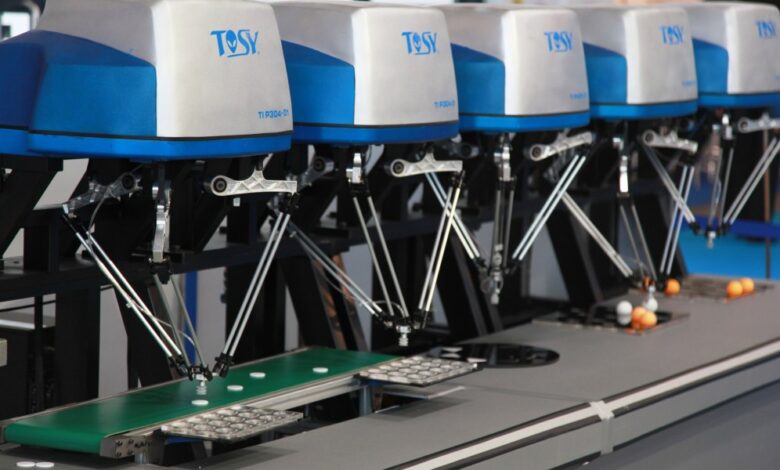Exploring the Benefits of Parallel Manipulators in Industrial Automation

In the life of industrial automation, requirements for accuracy, speed, and flexibility constantly increase. Industries are always exploring new methods to make their processes more efficient and cost-effective without sacrificing quality. The parallel manipulator is one device that has proven extremely useful in addressing these problems.
A parallel manipulator is a robotic mechanism in which multiple independent actuators work in parallel to move a single platform with high precision. These manipulators are adopted in industrial use, including assembly lines and complex machining processes. In this post, we’ll take a closer look at the top advantages of parallel manipulators for industrial automation and how they are changing the way the world builds.
What is a Parallel Manipulator?
A parallel manipulator consists of a fixed base and a moving platform, which are connected by independent actuators that act independently from each other. The platform is movable through the actuators working in concert, enabling highly accurate movements and positions. In contrast to serial manipulators, parallel manipulators have superior rigidity, load capacity, and response speed because no actuator is located in series.
The Advantages of Using Parallel Manipulators in Industrial Automation
1. High Precision and Accuracy
One of the most important characteristics of a parallel manipulator is its ability to execute movements with very high accuracy and precision. Parallel manipulators are a workhorse solution in high-precision industries such as aerospace, electronics, and medical device manufacturing. The parallel arrangement of the actuators makes platform movement controllable, avoiding mistakes and making placement with the desired accuracy possible.
In high-precision work such as CNC machining or semiconductor assembly, even small inaccuracies can lower the quality of the end product. Due to the strong stiffness of parallel manipulators, they offer excellent error reduction and can complete complex tasks with high precision.
2. Increased Speed and Efficiency
Speed is often crucial in industrial settings, such as rapid assembly lines or during high-demand manufacturing periods. Since parallel manipulators use multiple actuators working simultaneously, they can achieve higher task performance than conventional serial manipulators. This simultaneous operation reduces the time needed to perform each task, resulting in higher productivity.
Moreover, parallel manipulators can move more quickly due to the parallel utilization of actuators, enabling fast assembly, inspection, or packaging. The result is improved efficiency and reduced downtime, which is perfect for industries that depend on continuous production.
3. Enhanced Rigidity and Stability
Parallel manipulators exhibit greater rigidity than their serial counterparts. Because the actuators are arranged in a parallel structure, the load is shared among them, making the system more stable and resistant to vibrations. This is especially important in stability-sensitive applications, where handling both heavy and delicate materials is necessary.
The robust structure of parallel manipulators allows them to carry high payloads and perform high-performance operations without sacrificing operational quality. For example, in material handling or packaging applications, enhanced stability helps ensure that the objects being handled are treated gently, reducing the likelihood of damage.
4. Reduced Deflection and Deformation
In industrial automation, deflection and deformation of robotic arms or platforms during operation can cause a loss of accuracy and reliability. Parallel manipulators are less susceptible to these issues due to the more distributed load and reduced impact of external forces. This is especially important when working with heavy materials or during high-stress operations like welding and cutting.
The reduction in deflection ensures that the platform stays in the required position, which is vital for accurate processes such as positioning, welding, and painting. By minimizing these errors, parallel manipulators help ensure that final products meet the required standards.
5. Compact Design and Flexibility
One major advantage of parallel manipulator is their compactness. Because multiple actuators work together in parallel, the system can be much smaller and more flexible than traditional robotic arms. This compactness allows parallel manipulators to be integrated into small workstations or other areas with limited floor space in factories and warehouses.
Furthermore, parallel manipulators offer reconfigurability, making them ideal for manufacturers who need to move quickly from one product line to another. This flexibility reduces the need for costly specialized equipment, making companies more adaptable to changing customer demands.
6. Improved Energy Efficiency
Another benefit of parallel manipulators is their energy efficiency. While serial robots often require multiple joint movements to perform a task, parallel manipulators can achieve the same results with lower energy consumption. Their design allows for more efficient use of power, resulting in lower operating costs.
In energy-intensive industries, the ability to optimize energy use is a significant advantage. Parallel manipulators also help companies reduce their environmental impact and operating costs through improved energy efficiency.
7. Cost-Effectiveness in the Long Term
While the initial investment in parallel manipulators may be higher than that of serial manipulators, the long-term benefits justify the investment. Over time, significant cost savings are realized due to enhanced performance, reduced downtime, and energy savings. Additionally, parallel manipulators are characterized by their high precision, stability, and low maintenance, which further increases their cost-effectiveness.
Companies can also benefit from the long lifespan of parallel manipulators, making them an intelligent choice for improving automation and overall production performance.
Conclusion
The deployment of parallel manipulators in industrial automation has dramatically changed how production and manufacturing activities are carried out. These robots offer unmatched precision, speed, and stability, which is why they are favored in high-end, high-volume manufacturing industries.
Parallel manipulators are highly efficient, consume less energy, and offer better flexibility, meeting the demands of modern industry development. Their versatility and cost-effective design make them an essential technology for developing automated, nimble, and efficient manufacturing systems.
Parallel manipulators are not just a trend in industrial automation but have become a “must” for companies striving to remain competitive while adhering to the highest standards of quality and productivity. With so many benefits, these robots are paving the way for the future of industrial automation.




